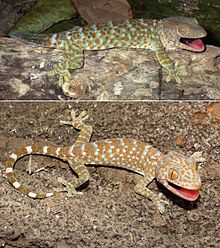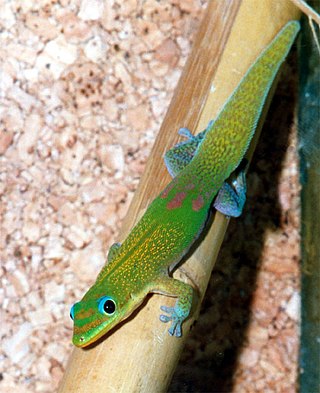
Geckos are small, mostly carnivorous lizards that have a wide distribution, found on every continent except Antarctica. Belonging to the infraorder Gekkota, geckos are found in warm climates throughout the world. They range from 1.6 to 60 centimetres.

Lizard is the common name used for all squamate reptiles other than snakes, encompassing over 7,000 species, ranging across all continents except Antarctica, as well as most oceanic island chains. The grouping is paraphyletic as some lizards are more closely related to snakes than they are to other lizards. Lizards range in size from chameleons and geckos a few centimeters long to the 3-meter-long Komodo dragon.

Gekkonidae is the largest family of geckos, containing over 950 described species in 62 genera. The Gekkonidae contain many of the most widespread gecko species, including house geckos (Hemidactylus), the tokay gecko (Gekko), day geckos (Phelsuma), the mourning gecko (Lepidodactylus), and dtellas (Gehyra). Gekkonid geckos occur globally and are particularly diverse in tropical areas. Many species of these geckos exhibit an adhering ability to surfaces through Van der Waals forces utilizing intermolecular forces between molecules of their setae and molecules of the surface they are on.

Gekko is a genus of Southeast Asian geckos, commonly known as true geckos or calling geckos, in the family Gekkonidae. Although species such as Gekko gecko are very widespread and common, some species in the same genus have a very small range and are considered rare or endangered.

The golden gecko, also known commonly as Baden's Pacific gecko, is a species of lizard in the family Gekkonidae. The species is native to Vietnam.

Gekko smithii, commonly known as Smith's green-eyed gecko or the large forest gecko, is a species of lizard in the family Gekkonidae. The species is native to mainland Southeast Asia and Indonesia.

The flat-tailed house gecko, also known as the frilled house gecko or Asian house gecko, is a species of Gekkonidae native to southeastern and southern Asia. The species is sometimes classified under the genus Cosymbotus.

Gekko kuhli, commonly known as Kuhl's flying gecko, Kuhl's parachute gecko, or the gliding gecko, is a species of lizard in the family Gekkonidae. The species is found in Southeast Asia.
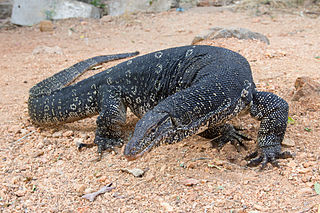
The Asian water monitor is a large varanid lizard native to South and Southeast Asia. It is widely considered to be the second-largest lizard species. It is distributed from eastern and northeastern India and Bangladesh, the Andaman and Nicobar Islands, Sri Lanka, through southern China and Hainan Island in the east to mainland Southeast Asia and the islands of Sumatra, Borneo, Java, Lombok, the Riau Archipelago, Sulawesi. It is one of the most widespread monitor lizards.

The common house gecko is a gecko native to South and Southeast Asia as well as Near Oceania. It is also known as the Asian house gecko, Pacific house gecko, wall gecko, house lizard, tiktiki, chipkali or moon lizard.

Lauhachinda's cave gecko is an endangered species of lizard in the family Gekkonidae. The species is endemic to Thailand.
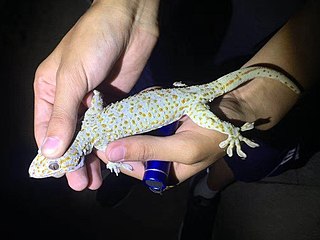
Reeves's tokay gecko is a species of lizard in the family Gekkonidae. The species is endemic to Asia.
Bonkowski's gecko, also known commonly as kap ke Bonkowski in Laotian, is a species of lizard in the family Gekkonidae. The species is endemic to Laos.
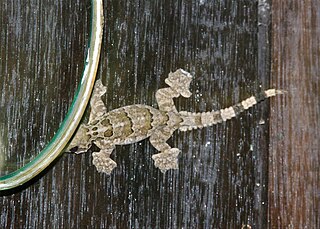
Gekko horsfieldii, also known commonly as Horsfield's flying gecko, Horsfield's gliding gecko, and Horsfield's parachute gecko, is a species of lizard in the family Gekkonidae. The species is endemic to Asia.


